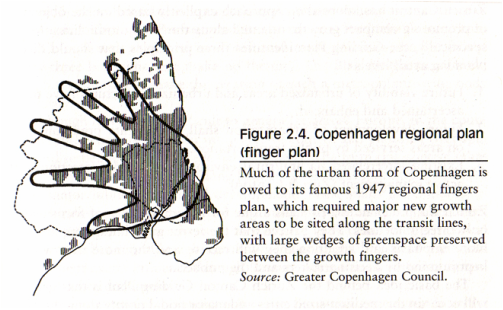I think perhaps TigerMaster is primarily concerned with new/current policies and direction we are going in whereas Adjei is focused on historical inspiration.
I think it is totally undeniable to say we have had a huge American influence. Toronto was very much an industrial city like many other Great Lake cities and later went through the standard deindustrialization and suburbanization (though TigerMaster's note on the diminished racial aspect is noteworthy).
Where we differ however is that many of the highways that were proposed (Fig 1)(Fig. 2) that would have made us more like Atlanta weren't constructed and the nodal approach to planning in creating many localized downtowns like STC, NYCC, etc.. (I think I remember reading once that a prominent city official in Toronto back in the day was quoted as saying something like this was inspired by Los Angeles which was considered preeminent modern city at the time). Seriously look at the highway systems of Detroit, Chicago, or even lesser cities like Cleveland, and compare them to Toronto's. The nodes are also notable because it limited the creation of a typical Concentric zone model city (I guess the historical example would be Chicago) and I think ours are more residential (if not mostly!) compared to what you'd expect in an American Edge City. The lack of these highways and the fact that most suburban subdivisions were built adjacent to the fringes (no leapfrogging) kind of kept Toronto pretty dense and compact compared to American cities. Chicago does not really have high-rises out of downtown really whereas Toronto has several, particularly near those nodes. I'm not too familiar with Asia but the impression that I get from images, video, and online is that having high-rises outside of a defined city centre is pretty normal. I think South America is similar to this as well, I remember being very young and going to Caracas (before it was a global murder capital) and I do recall there being high-rises all over the place not unlike Scarborough or North York.
As for transit planning now and for the future I would not disagree that we look to places such as Europe for inspiration. We are clearly trying to move away from auto-centric planning and moving toward a more transit-based one and I think the Avenues plan is a perfect example of that. It just so happens that those plans have historically been associated with places like Europe (Fig.3), whereas the auto-centric one was associated with American planning. I still however wouldn't say we didn't develop car culture though. Having grown up in northern Richmond Hill when it was pretty much the very fringe of the GTA to the north and having regularly interacted with places like Vaughan and Markham there was and still is a car culture. But yes, it's not quite as bad as some American cites.
Now, the idea that we continue to call one form American and the other European or Asian I think is where the true problem is. As Adjei mentioned, you could have a very dense and city with great transit in the United States and I will go further in saying you could just as well have a very auto-centric society in Europe. Many of the former Eastern Bloc countries have huge roadways and have very hostile environments to pedestrians. I was even surprised to hear when my girlfriend visited relatives living in Catania that she would always go to the mall and there it was very difficult to get around without a car (I later Google Maps/Streetviewed it and sure enough there was a big mall next to a highway). While I once again admit to know little about Asia, just looking at the area surrounding the Jin Mao and Oriental Pearl Towers in Shanghai seems like its very auto-centric. I think it just a matter of following the lead or being inspired by the places and cities that did something very successfully. Before when we were looking at building highways and suburbs the leaders happened to be cities in the United States, now we are focusing on Smart Grown, intensification, and Urban Growth Centres which is a direction that perhaps Europe and Asia succeeded better at. That being said there are also a few North American cities worth looking at for transit inspiration (particulalry for LRTs). It wouldn't surprise me if the American cities we are may be taking inspiration from are too looking at European or Asian examples. I don't think it's about what continent it's from, but about looking at successful examples and seeing if they can be reproduced here. Hell, I could say that we in the GTA are taking an aggressive South American (Curitiba, Bogota) approach to urbanism with the rise of BRT systems in York and Peel Regions. It's not about where it comes from, it's about whether or not it works.
Fig.1
Fig. 2
Fig. 3 Copenhagen's five finger plan







